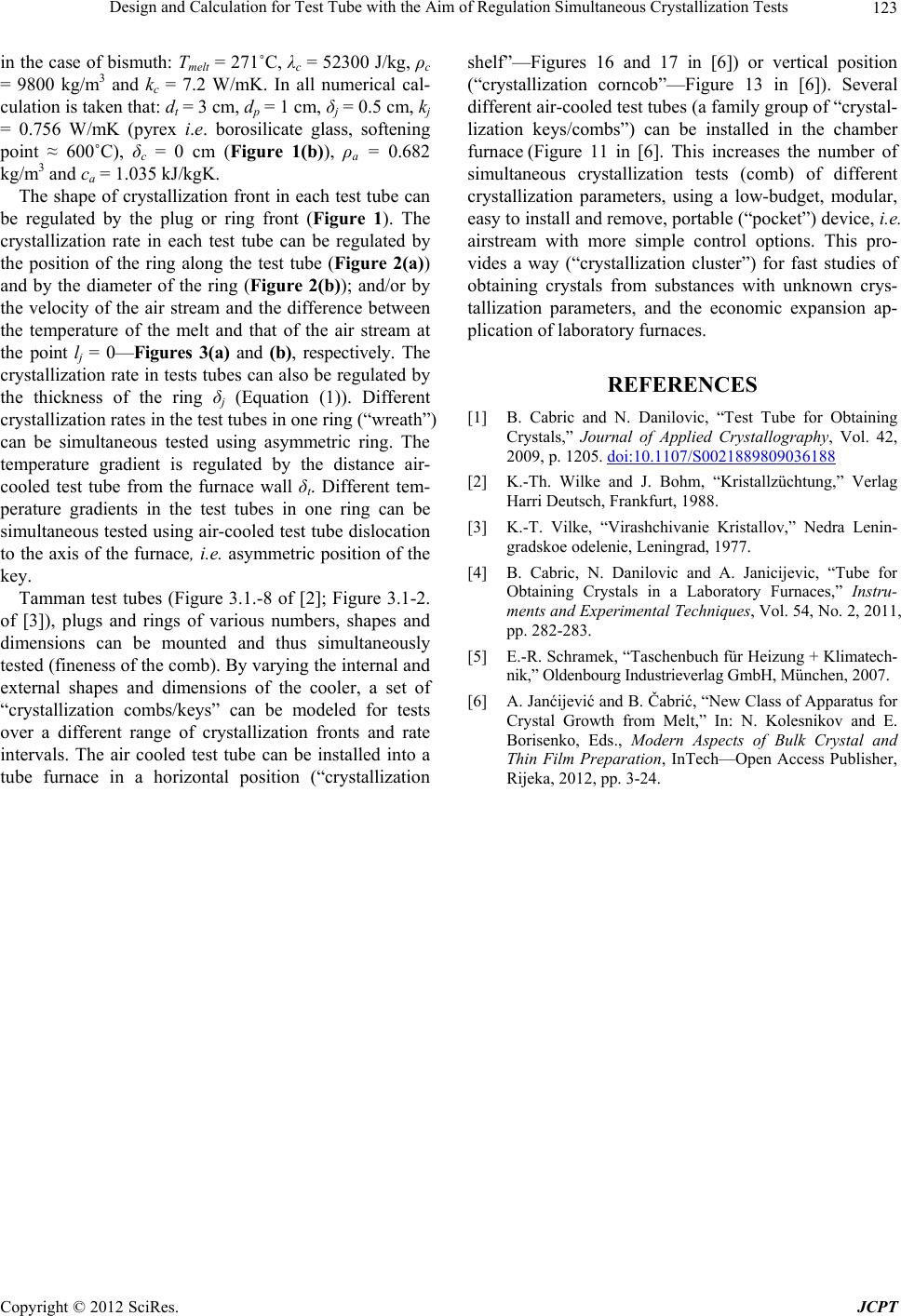
Design and Calculation for Test Tube with the Aim of Regulation Simultaneous Crystallization Tests
Copyright © 2012 SciRes. JCPT
123
in the case of bismuth: Tmelt = 271˚C, λc = 52300 J/kg, ρc
= 9800 kg/m3 and kc = 7.2 W/mK. In all numerical cal-
culation is taken that: dt = 3 cm, dp = 1 cm, δj = 0.5 cm, kj
= 0.756 W/mK (pyrex i.e. borosilicate glass, softening
point ≈ 600˚C), δc = 0 cm (Figure 1(b)), ρa = 0.682
kg/m3 and ca = 1.035 kJ/kgK.
The shape of crystallization front in each test tube can
be regulated by the plug or ring front (Figure 1). The
crystallization rate in each test tube can be regulated by
the position of the ring along the test tube (Figure 2(a))
and by the diameter of the ring (Figure 2(b)); and/or by
the velocity of the air stream and the difference between
the temperature of the melt and that of the air stream at
the point lj = 0—Figures 3(a) and (b), respectively. The
crystallization rate in tests tubes can also be regulated by
the thickness of the ring δj (Equation (1)). Different
crystallization rates in the test tubes in one ring (“wreath”)
can be simultaneous tested using asymmetric ring. The
temperature gradient is regulated by the distance air-
cooled test tube from the furnace wall δt. Different tem-
perature gradients in the test tubes in one ring can be
simultaneous tested using air-cooled test tube dislocation
to the axis of the furnace, i.e. asymmetric position of the
key.
Tamman test tubes (Figure 3.1.-8 of [2]; Figure 3.1-2.
of [3]), plugs and rings of various numbers, shapes and
dimensions can be mounted and thus simultaneously
tested (fineness of the comb). By varying the internal and
external shapes and dimensions of the cooler, a set of
“crystallization combs/keys” can be modeled for tests
over a different range of crystallization fronts and rate
intervals. The air cooled test tube can be installed into a
tube furnace in a horizontal position (“crystallization
shelf”—Figures 16 and 17 in [6]) or vertical position
(“crystallization corncob”—Figure 13 in [6]). Several
different air-cooled test tubes (a family group of “crystal-
lization keys/combs”) can be installed in the chamber
furnace (Figure 11 in [6]. This increases the number of
simultaneous crystallization tests (comb) of different
crystallization parameters, using a low-budget, modular,
easy to install and remove, portable (“pocket”) device, i.e.
airstream with more simple control options. This pro-
vides a way (“crystallization cluster”) for fast studies of
obtaining crystals from substances with unknown crys-
tallization parameters, and the economic expansion ap-
plication of laboratory furnaces.
REFERENCES
[1] B. Cabric and N. Danilovic, “Test Tube for Obtaining
Crystals,” Journal of Applied Crystallography, Vol. 42,
2009, p. 1205. doi:10.1107/S0021889809036188
[2] K.-Th. Wilke and J. Bohm, “Kristallzüchtung,” Verlag
Harri Deutsch, Frankfurt, 1988.
[3] K.-T. Vilke, “Virashchivanie Kristallov,” Nedra Lenin-
gradskoe odelenie, Leningrad, 1977.
[4] B. Cabric, N. Danilovic and A. Janicijevic, “Tube for
Obtaining Crystals in a Laboratory Furnaces,” Instru-
ments and Experimental Techniques, Vol. 54, No. 2, 2011,
pp. 282-283.
[5] E.-R. Schramek, “Taschenbuch für Heizung + Klimatech-
nik,” Oldenbourg Industrieverlag GmbH, München, 2007.
[6] A. Janćijević and B. Čabrić, “New Class of Apparatus for
Crystal Growth from Melt,” In: N. Kolesnikov and E.
Borisenko, Eds., Modern Aspects of Bulk Crystal and
Thin Film Preparation, InTech—Open Access Publisher,
Rijeka, 2012, pp. 3-24.